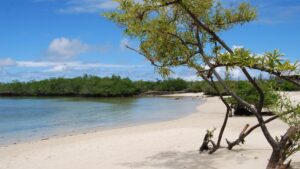North Seymour Island was uplifted from the seafloor by a seismic event. Originally part of the ocean floor, the island rose from its lowest point to its highest elevation of only 30 meters. The cliffs of the small island (1.9 km²) are only a few meters high and form the coastline. Swallow-tailed gulls perch on the rocky ledges, while a small forest of silvery-gray Palo Santo trees adds to the scenery. These trees are usually leafless, waiting for rain to bloom.
North Seymour Island is full of life, and you might need to make room for a sea lion or an iguana. The blue-footed boobies nest on both sides of the nearly 2 km-long path, where pairs perform their courtship dance to mate. Even along the rocky coastline, a remnant of white sand remains inland from the sea.
Large flocks of seabirds gather for an impressive feeding display. The trail winds inland, leading to the largest nesting site in Galapagos for the magnificent frigatebird. These huge dark acrobats have a five-foot wingspan; the males, with their inflated red throat pouches, perch precariously on low shrubs to care for their equally large chicks. Silver gulls also nest here, and other bird species are often spotted. Sea lions and the endemic black marine iguanas are common, and with a bit of luck, you might also see land iguanas and sea lions.


















